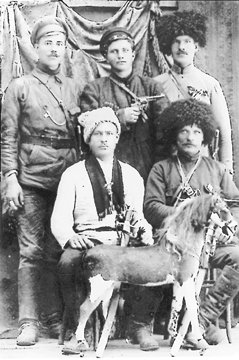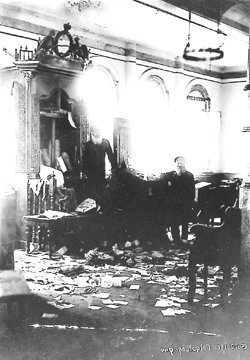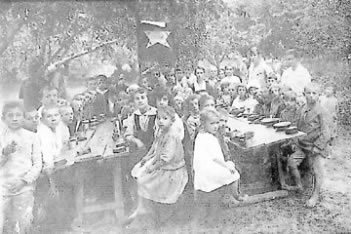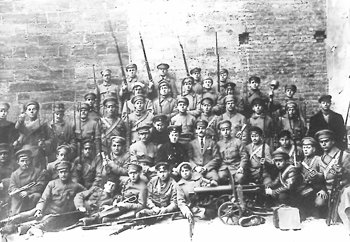Jews in the Soviet Union up to 1940
(Part 2of 3)
The Pogroms During the Civil War 1918 - 1921
The civil war that breaks out after the Bolshevik Revolution turns the Ukraine, where 60 percent of Russian Jews live, once again into a battlefield. A number of armies, armed gangs and units, each with a different objective, enter the conflict.



At your left,
members of Ataman Struk's band, responsible for a great number of pogroms in
the Chernobyl area, posing in front of a toy horse.
In the middle,
the synagogue of Demievka, Ukraine, vandalized in 1919 by Polish forces.
At your right,
"Peace and Freedom in Sovdepya (Soviet Republic)" an anti-Semitic
poster portraying Trotsky, published by the Whites.
In spring 1918, the Red Army has to defend itself against the Germans, the Ukrainian Army under Petlyura struggling for Ukrainian independence, and the "White" Armies under Denikin and Wrangel that try to topple the Bolshevik government. Apart from these more organized armies, armed gangs of bandits under their own leaders (atamans) join the fighting. All groups take part in anti-Jewish attacks, looting and murder. Only the Red Army Command prohibits anti-Semitic violence and even punishes some of the attackers.


At your left,
corpses of Jews killed by Ataman Struk's band before their burial; Ivankoff,
1919. Neither Struk nor any other Ataman was ever arrested for the killings.
At your right,
orphans from Kovshitsy at the Bobruisk Children's Home. Between 1914 and 1921,
an estimated 300,000 Jewish children were orphaned. The Soviet government allowed
Western organizations such as the American Jewish Joint Distribution Committee
to give aid to pogrom victims.
No such policy is introduced in the Ukrainian Army. During 1919, when the Ukrainians have to retreat, anti-Jewish violence on an unprecedented scale claims tens of thousands of lives. None of the perpetrators is prosecuted. The majority of Jews in the Ukraine, fearful of Ukrainian independence, come to regard the Red Army more and more as the only force capable to stop the violence.


At your left, Odessa Jews killed in a pogrom during the Civil War.
At your right, Jewish self-defense unit from Odessa, photographed in April 1918.
The other major participant in the Civil War, the "White" Army, also engages in looting, rape and murder, using the old slogan "Strike at the Jews and Save Russia." When they have to retreat southward at the end of 1919, they vent their rage on Jewish communities along the way. Jewish self-defense units are occasionally able to stop them, partly with material support from the Soviet government.
By the time the Civil War is over, about 2,000 pogroms have left an estimated 100,000 Jews dead and more than half a million homeless.